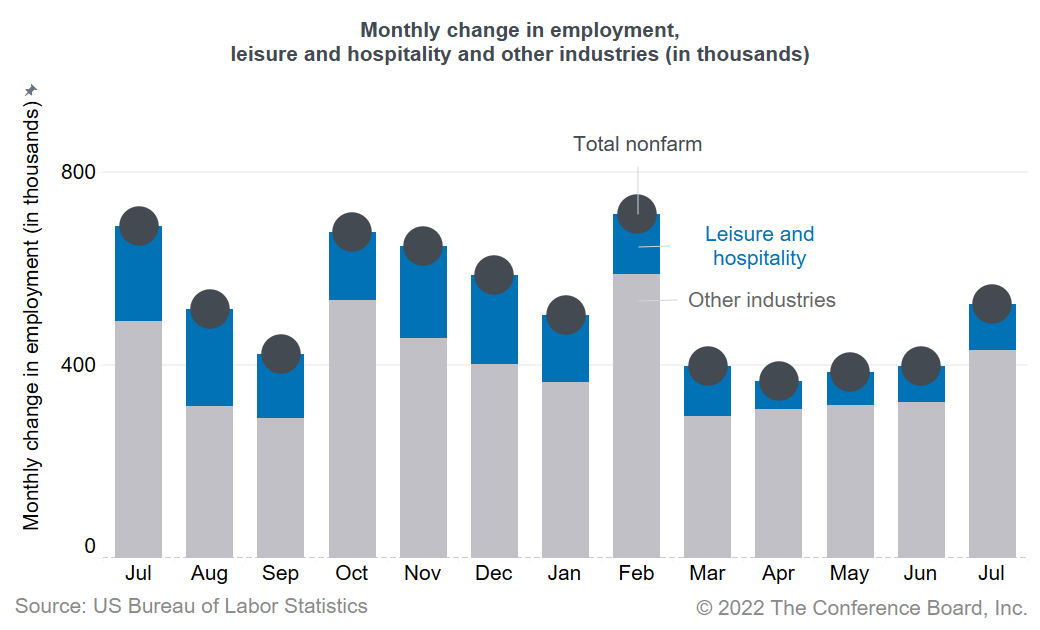
Today’s job report showed another strong month for payrolls, with 528,000 jobs added in July 2022, after an upwardly revised increase of 398,000 jobs in June. Thus far, the buoyant labor market is still defying headwinds in the rest of the economy, where economic activity has slowed. Usually, hiring decisions react to changes in business activity a few months later. Therefore, hiring is likely to decelerate over the coming months. The unemployment rate ticked down to a historically low 3.5 percent in July 2022, down from 3.6 percent in June. The labor force participation rate decreased slightly to 62.1 percent in July, down from 62.2 percent in June. Overall, employment has now returned to its pre-pandemic level (February 2020). Job recovery has been somewhat slower for women, with employment still 0.1 percent below the pre-pandemic level, whereas employment for men now exceeds the pre-pandemic level by 0.2 percent. Job growth remains strong in leisure and hospitality, which added 96,000 jobs in July, although recent job gains are twice as small as a year ago. Across most other industries job growth was strong. Jobs were gained in professional and business services (89,000), health care and social assistance (96,600), manufacturing (30,000), retail trade (21,600), and transportation and warehousing (20,900). The labor market is still very tight and wage growth remains elevated. While job openings and quits rates are still historically high, job openings—a good leading indicator for employment changes—have fallen for three consecutive months. This may indicate that softening in labor demand lies ahead. With inflation still elevated and the labor market robust, the Fed will likely continue to rapidly raise interest rates over the coming months. While economic output contracted for two consecutive quarters in the first half of 2022, a strong labor market means that currently we are likely not in recession. However, economic activity is expected to further cool towards the end of the year and it is increasingly likely that the US economy will fall into recession before yearend or in early 2023. The unemployment rate would likely rise following slowing economic activity and possible job losses although currently we expect the unemployment rate to remain below 4.5 percent in 2023. Labor force participation would decline as job opportunities diminish. Wage growth will likely cool as employee bargaining power weakens and businesses need to manage costs. In reaction to slowing economic activity, companies will likely reduce or freeze hiring as a first step towards cost reductions. Depending on the gravity of the decline in economic activity, companies may reduce hours, bonuses, and wages, or turn to furloughs and layoffs. Lower-skilled workers would be more vulnerable to job losses, as also seen in earlier recessions when unemployment rates rose more for these workers. However, severe difficulties in finding and retaining workers over the last two years may prompt employers to be more careful about laying off workers. In addition, in in-person services, where the number of jobs is still recovering and 7 percent below pre-pandemic level, there may be less need for downsizing.Commentary on today’s U.S. Bureau of Labor Statistics Employment Situation Report

March Payrolls: The Calm Before the Tariff Storm
April 04, 2025
February Jobs Report Hints at Growing Uncertainty
March 07, 2025
Stability Underneath January’s Noisy Jobs Report
February 07, 2025
Q4 ECI Wage Deceleration Slows
February 07, 2025
Robust Job Gains Close 2024
January 10, 2025
November Job Gains Rebound from Disruptions
December 06, 2024
Charts
Preliminary PMI indices show no change in weak DM growth momentum in November
LEARN MORECharts
Members of The Conference Board can access all underlying data of the Job Loss Risk Index by Industry in this Excel workbook.
LEARN MORECharts
While a US recession appears to be imminent, it will not look like any other in recent history.
LEARN MORECharts
CEOs’ views of current and future economic conditions remain pessimistic as they prepare for near-inevitable US and EU recessions.
LEARN MORECharts
The US economy appears to be on the precipice of recession.
LEARN MORECharts
Measure of CEO Confidence declined for the fifth consecutive quarter in Q3 2022 and has hit lows not seen since the start of the COVID-19 pandemic in 2020.
LEARN MOREPRESS RELEASE
Survey: In 2024, CEOs Are Most Worried About a Recession & Inflation, But S…
January 10, 2024
PRESS RELEASE
As Labor Day Approaches, HR Leaders Say Hiring
August 29, 2023
IN THE NEWS
CEOs Are Predicting a Mild Recession in the U.S.
June 01, 2023
PRESS RELEASE
Global Productivity Growth Set to Disappoint Again in 2023
May 17, 2023
IN THE NEWS
Dana Peterson on Why Recession is Likely in 2023
April 20, 2023
PRESS RELEASE
Which Industries Will Start Shedding Jobs?
April 05, 2023
